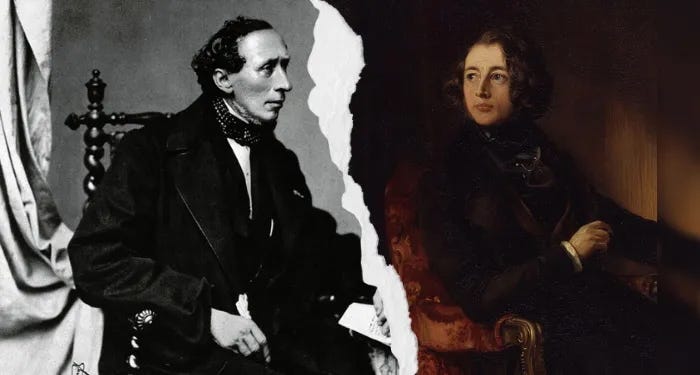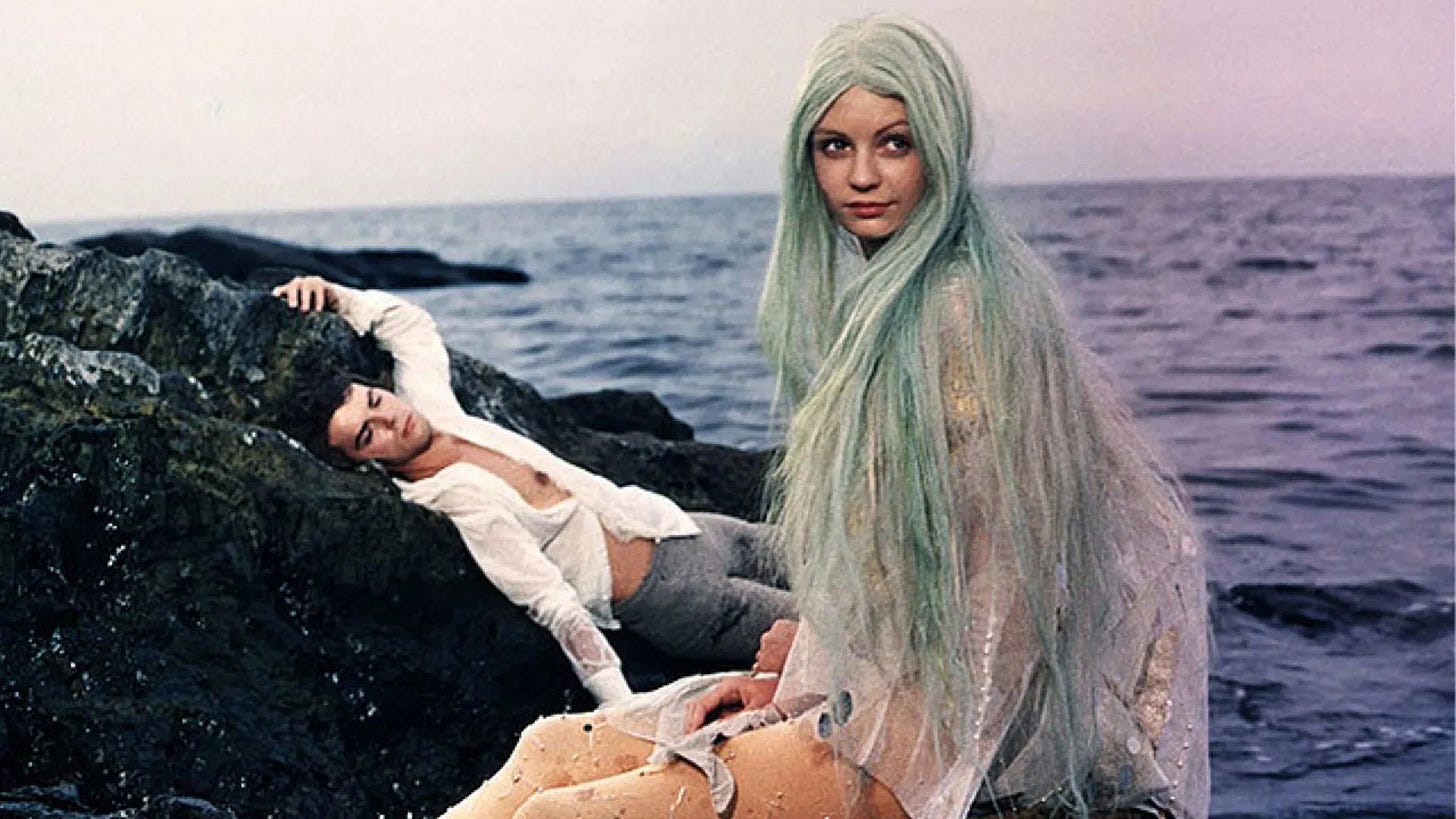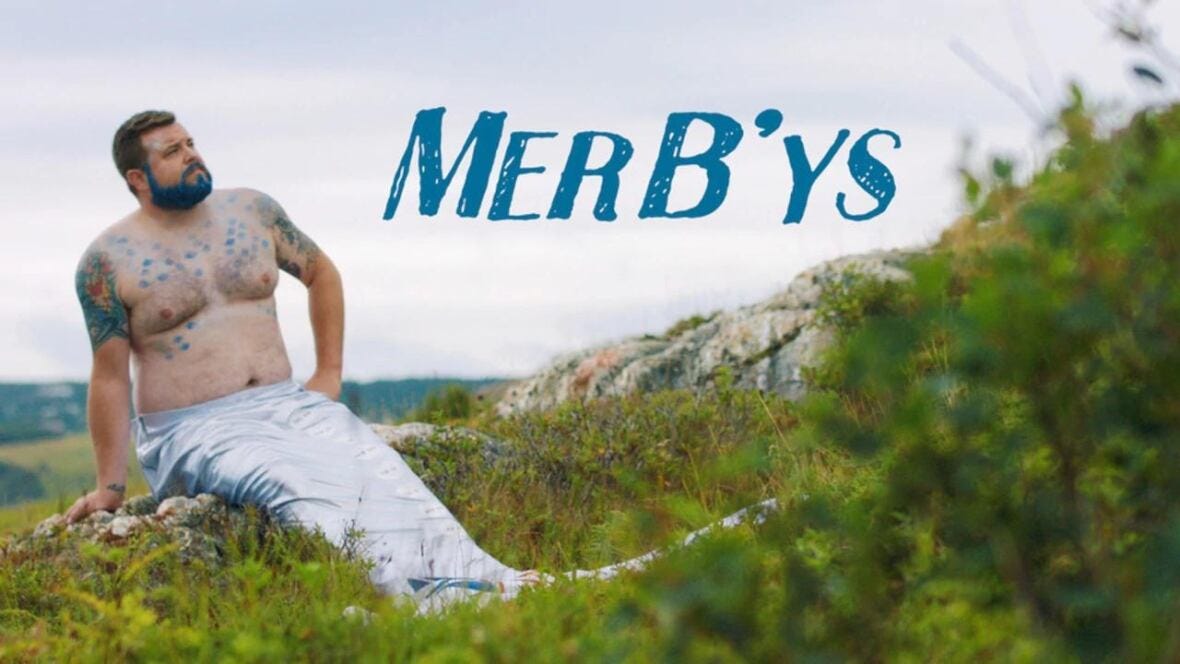Watch or read
I didn’t come up with #MerMay, but I’ll follow along with any ‘National Day of’ or social media hashtag that can give me an idea of what to write about.
Though I’ve been wanting to write something about mermaids vs sirens (fish vs bird is the short version), I want to continue writing about where fairy tales come from (previously in short form videos: Grimms, Women behind the Grimms, Charles Perrault, the forgotten women who wrote alongside Charles Perrault). Our most famous mermaid came from Hans Christian Andersen, so I’ll cede the month of mermaids to him, and his tragic unrequited love-filled life.
The Little Mermaid
First published in 1937 in his collection, Fairy Tales Told for Children, the story was inspired by Undine, a novella published in 1811.
If you are only familiar with the Disney version(s), I suggest you read HCA’s story. You can read it online here. Or at least read the Wikipedia summary.
Reading HCA’s story after only knowing the Disney version, I was delighted to read about the sea witch. Of course, Ursula is one of the best Disney fairy tale villains with one of the best songs (actually Disney’s The Little Mermaid might be my favourite of the animated fairy tales because it has the best music) but HCA’s sea witch isn’t even a villain. As far as I can tell, she is just a business woman doing her business. She doesn’t cut out the little mermaid’s tongue for any nefarious plan; it is simply the cost of doing the magic. This sea witch is begging for her side of the story to be told.
Another highlight for me, compared to Disney, is her sisters. They go to the sea witch for their own spell to help get their sister back. This leads to the tragic ending, which, if you know me, you could guess is the part I most want to rewrite. Of course I want the little mermaid to stab him and go back to the sea! It’s just too pathetic for her to have the knife and still just passively let herself die. (And I can’t even get into the weird Christian ending for children. P. L. Travers called it “blackmail.” lol) It’s emblematic of HCA’s stories; his characters are often pathetic creatures unable to do anything for themselves, instead just watching the world go by without them.
Queer Interpretation
Many readers and scholars find the theme of unrequited queer love in the tale. The little mermaid wants to fit in with a group of people unlike her. She has great love for someone who cannot understand her love, who treats her like a platonic friend, who would never consider her as a potential romantic/sexual partner. Who among us has not fallen for a straight friend, hmm?
At that time, and still now among some groups, being queer was at odds with being Christian. You could not be both. HCA could have been writing about his inner conflict between his love for men (one man in particular—I’ll get to that) and his Christian beliefs. Would he have to choose between sharing his love and keeping his soul pure for heaven?
Before I get to HCA’s real life queer love(s), allow me another interpretation. I saw a colonial allegory here. (Note: I am a white person living in Canada, a descendant of European settlers, so I do not speak for or from an Indigenous perspective.) The humans are not invading the sea, no, but the mermaid has been exposed to another group’s way of living and religion. They promise an immortal soul. Some Indigenous people wanted to join Christianity and live with the European settlers. (Somehow, Christian explorers and missionaries have managed to make Christianity sound like a good deal to many peoples around the world.) So, the mermaid wants to join them and ‘earn’ her Christian immortal soul. They accept her—to a degree. Yes, you can stay, but not as an equal. The mermaid is treated like a pet, a novelty, a sub-human to be trotted around for entertainment. The mermaid and the humans cannot communicate in the same language.
Her treatment like a pet also reminds me of the treatment of little people as entertainers of royals in the medieval era for centuries and so-called ‘freaks’ of the Victorian era (don’t get me started on what I learned about P.T. Barnum), who were accepted in society but only in a certain role: as anomalies to be looked at, to be put on display, treated like pets, but never considered equal humans, let alone considered for romantic/sexual relationships (if they were, it would be considered a fetish, which is still an issue today).
I’m sure there are many other interpretations that people can relate to: transformation, belonging, chasing dreams, unrequited love, etc. For HCA, we’ve gotta see the queerness.

HCA was in love with many people; a timeline or some kind of chart might be helpful to connect his personal dramas to his tales. “The Little Mermaid” may have been inspired by his love for his friend Edvard Collin. Andersen wrote to him: "I languish for you as for a pretty Calabrian wench ... my sentiments for you are those of a woman. The femininity of my nature and our friendship must remain a mystery." Collin wrote in his own memoir, "I found myself unable to respond to this love, and this caused the author much suffering."
Unrequited love and feeling out-of-place are themes in many HCA stories. In “The Snowman,” a snowman falls in love, from afar, with the beautiful iron stove inside the kitchen. A love that could never be, of course. The snowman melts in the warm spring sun, never having met his beloved. Like many queer kids, Andersen must have felt like “The Ugly Duckling” until he grew into himself and started expressing his love for others. The titular “Snow Queen” is said to have been inspired by famous opera singer Jenny Lind, who never reciprocated his affections. His unrequited affections were not always romantic: let us not forget the time he visited Charles Dickens and overstayed his welcome by five weeks. He didn’t understand he was unwelcome and was saddened by Dickens ceasing their correspondence after he left.
Mermaids, Gays, and Theys
It’s not surprising, then, that mermaids are a favourite expression of queer and gender-non-conforming people. Who doesn’t love a drag mermaid? The metaphors are abound: feeling like you’re from another world, unrequited love, feeling only half-human, longing to escape to another world, transforming one’s body into what feels more true to one’s self, and more. The aesthetics: shimmering scales, long flowing colourful hair, and seashell tops. Like unicorns, mermaids seem synonymous with LGBTQ+ expression, for all their colourful, transformative meanings. In St. John’s, Newfoundland, there is a group of men dressing up as mermaids for a charity calendar. But it’s no joke; these men use these photoshoots to find a new way to express their gender and love their bodies. The short documentary, Merb’ys, is heart-warming.
I’ve shared a taste, but there’s much more to say about mermaids and other marine folkloric creatures, and Hans Christian Andersen’s beautiful and tragic stories. I recommend picking up an HCA collection to get to know more of his stories; “The Snow Queen” is nothing like Frozen, “The Fir Tree” will break your heart at Christmas, and “The Wild Swans” is a beautiful version of “The Six Swans” fairy tale. Andersen solidified the mermaid story as one of longing for love and the human world, but there are many more stories of aquatic creatures with different relationships with humans; they love ‘em and leave ‘em, bring them under the water to play, lend them a helping hand, or just kill them. Pick up a book or go on a Wikipedia deep dive and explore the global variations of mermaids and similar creatures. There’s a water spirit out there for everyone.





Funny you mention all this. I’ve just finished NaPoWriMo. My theme was The Little Mermaid, and I now have a 30 poem chapbook of poems riffing on the HCA fairy tale.